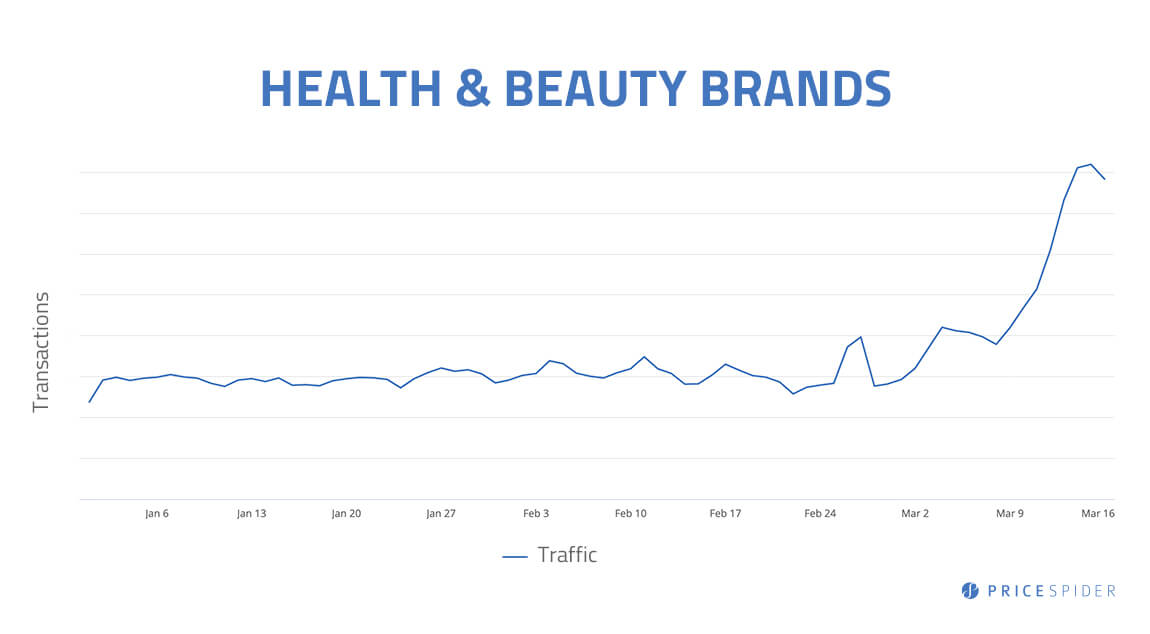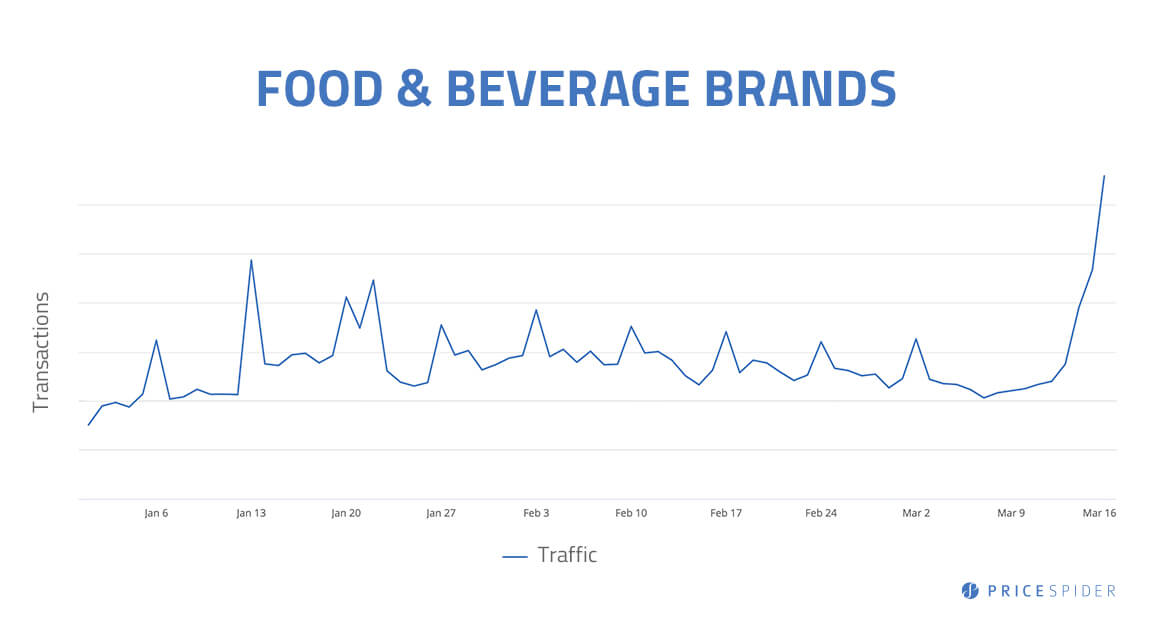As COVID-19 continues to spread around the world, its impact on daily life continues to shift, and no industry is more impacted than ecommerce.
For brands in ecommerce, it didn’t come as a shock that the frenzy surrounding the coronavirus would affect online sales and supply chains. But whether or not you’ve already felt the direct impact, it helps to know exactly how online shoppers are responding to COVID-19. Data trends from the PriceSpider platform and other sources are painting a very clear picture of what that means for brands.
Here are five ways coronavirus is impacting ecommerce.
1. People are stocking up—and not just on essentials
No surprise, shortly after the news broke that COVID-19 was in the US, hygiene and cleaning products like hand sanitizer, masks, and antibacterial wipes were immediately in short supply. Everywhere you looked, there was another reminder to use hand sanitizer, wear a mask if you had symptoms, and wipe down surfaces.
The PriceSpider Platform has seen an increase in traffic of 86% over this year’s average to brand sites in the health and beauty sector in just the past two weeks, which would include consumer goods such as soap, hand sanitizer, toilet paper, etc. This trend continues to grow and we are closely monitoring other industries that indicate a major shift in consumer shopping behavior. This shift is likely to significantly change consumer goods and food and beverage industries specifically.

But these aren’t the only kinds of products consumers have been stockpiling.
As people prepare for the possibility of quarantine and the scarcity of products, stores are running out of stock of seemingly unrelated household goods. A recent study by Nielsen found that “pandemic pantries” have led to a dramatic increase in sales for some surprising consumer packaged goods (CPGs), such as a 305% increase in sales of oat milk. Products with longer shelf lives are easier to stockpile, and people are purchasing more of everything they use regularly.
Food and beverage is another category that we are seeing trend up in ecommerce with an increase of over 80% in traffic to food and beverage brand sites through our platform in just the past few days.

2. Consumers are avoiding brick and mortar stores
Also as no surprise, people around the world are avoiding crowded public spaces per public health official guidance—including brick and mortar stores—and in the US, consumers say they are likely to avoid them. As news outlets, politicians, and local leaders continue to urge “social distancing” and avoid non-essential outings, this trend will only increase. Ecommerce brands have had mixed reactions about how they think the coronavirus will impact their bottom line, but even people who normally avoid online shopping are going to lean more heavily on ecommerce as the virus spreads. As a brand the most important thing during this time is to focus on your supply chains and work closely with retailers to help ensure they are stocked and prepared for this major increase in online traffic.
3. Perks and preferences are becoming less important
As retailers and brands run out of stock, consumers have fewer choices when it comes to where and how they buy. Top brands are unavailable. Urgency and availability are the biggest drivers in purchase decisions, and consumers are more likely to convert on products with shipping delays—simply because they have no other choice.
For brands that sell direct-to-consumer (D2C), this means retailer-specific perks and preferences will be less of an obstacle when shoppers decide where to buy. But that said, brands that only sell D2C or refuse to highlight retail partners are still going to be at a disadvantage. People want products as soon as possible, and during a crisis, that means finding what’s available right now. Making your products as easy as possible to find will be key during this time, so take a look at the buying options you provide on your website and expand them during this time to lessen the friction and increase the opportunity for consumers to find your products in stock, wherever that may be.
4. People just want to find where products are in stock
Go to any brick and mortar store in a region heavily impacted by coronavirus, and you’ll see rows of empty shelves. Nobody wants to waste their time (and increase their risk of exposure) going from store to store looking for the products they need. Consumers may be more willing to buy directly from brands during this time, but there’s an even greater opportunity to serve your customers during this crisis: show them where your products are still in stock.
With a Where to Buy solution, you can give your website visitors the ability to see stores in their area that carry your products, as well as whether or not they are in stock. Of course, when availability changes as quickly as it does right now, it’s also important to choose a solution that updates stock information frequently, so you don’t accidentally mislead your customers.
It might be tempting to see this as an opportunity to push hard for D2C-only, but even if you have the infrastructure to keep up with demand, you risk losing sales as people hunt for products in your category that they can pick up locally.
5. Brands are adjusting their supply chains
While the explosion in demand has put an increased strain on supply chains, many brands and retailers are also in the middle of conducting major overhauls to their supply chains—specifically, they’re trying to reduce their dependence on affected regions, as well as creating plans to modify their supply chains if a supplier is affected.
As the crisis grows, supply chain disruptions could become major pain points for brands and retailers, and it will be increasingly important for brands to leverage their retail partners and give their customers visibility into every channel their products are available through.
Streamline the path to purchase
Optimizing digital touchpoints so that the entire customer experience is as seamless as possible is a win for everybody and efficiency is needed during these trying times. Installing Where to Buy on your site transforms every product page into a shopping hub your customers won’t find anywhere else. They can compare pricing, availability, and product configurations without leaving your site, so they can get your products in the ways they want.
Having a live Where to Buy can also allow you to give buying options at every single interaction a potential customer has with you, ensuring they get the most efficient and prompt buying experience.
This is the ideal shopping experience for your potential customers. Want to see how it works?

